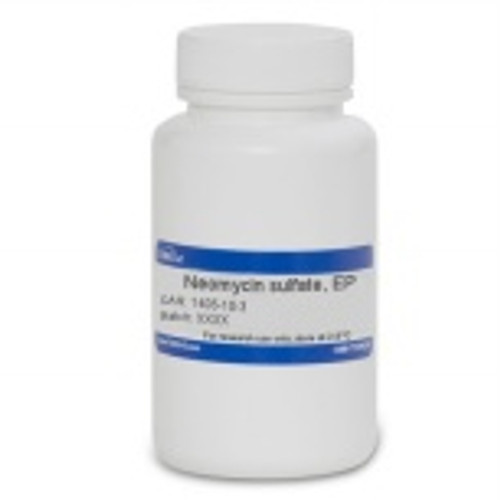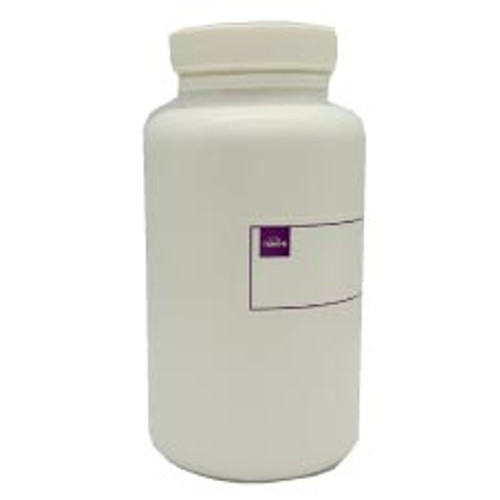Neomycin C Sulfate, EvoPure is the highly purified sulfate salt of Neomycin C, the stereoisomer to Neomycin B. Despite its similarity to Neomycin B, Neomycin C is thought to have ~ 35% of its biological activity. Highly pure Neomycin compounds can be used in cell culture, upstream biopharma, and cancer research.
We also offer:
- Neomycin Sulfate, USP (N003)
- Neomycin Sulfate, EP (N012)
- Neomycin A Sulfate (Neamine), EvoPure (N026)
- Neomycin B Sulfate, EvoPure (N019)
- Neomycin ReadyMadeTM Solution (N027)
Custom manufacturing and testing: We are able to prepare custom Neomycin components for your unique specifications. Additionally, we offer additional testing including endotoxin content, arsenic content, cell line testing, spectral analysis, and more. For more information, please contact us.
| Mechanism of Action | Aminoglycosides target the 30S ribosomal subunit resulting in an inability to read mRNA ultimately producing a faulty or nonexistent protein. |
| Spectrum | Neomycin is a broad-spectrum antibiotic, however, it is mostly used against Gram-negative bacteria. |
| Microbiology Applications | Neomycin can be used for gene selection, via exploiting the resistance gene (NPT II) (Aragão, 2009).
Neomycin is commonly used in clinical in vitro microbiological antimicrobial susceptibility tests (panels, discs, and MIC strips) against Gram-positive and Gram-negative microbial isolates. Medical microbiologists use AST results to recommend antibiotic treatment options. Representative effective ranges include:
For a representative list of Neomycin MIC values, click here. Neomycin Sulfate can be used for food testing in TSN agar to select for Clostridium perfringens and inhibit growth of Enterobacteria and Clostridium bifermentans. |
| Plant Biology Applications | Neomycin is commonly used in negative selections for plants which have been successfully been transformed with a plasmid conferring resistance via Agrobacterium mediated transformation. |
| Eukaryotic Cell Culture Applications | Neomycin is routinely used to select for cells containing resistance plasmids such as pcDNA3 in common cell lines including AtT-20. For additional information on your cell culture needs, please visit our cell-culture database. |
| Molecular Formula | C23H46N6O13 • xH2SO4 (lot specific) |
| References |
Aragão FJL and Brasileiro ACM (2009) Positive, negative and marker-free strategies for transgenic plant selection. Braz. J. Plant Physiol., 14(1):1-10 Dai S et al (2001) Comparative analysis of transgenic rice plants obtained by Agrobacterium-mediated transformation and particle bombardment. Mol. Breeding 7: 25–33 Davis BD (1987) Mechanism of bactericidal action of aminoglycosides. Microbiol. Rev. 51(3):341-50 PMID 3312985 Robertson JH (1971) Antimicrobial activity of Neomycin C against Staphylococcus epidermidis. Appl. Microbiol. 22(6): 1164-1165 PMID 5137586 Tsuji K and Robertson JH (1969) Comparative study of responses to Neomycins B and C by microbiological and gas-liquid chromatographic assay methods. App. Microbiol. 18(3):396-398 PMID 4907002 Wright JM and Collier B (1977) The effects of Neomycin upon transmitter release and action. J. Pharmacol. and Exper. Ther. 200(3):576-587 PMID 4907002 Yuan L and Wei H (2006) Rapid analysis of native Neomycin components on a portable capillary electrophoresis system with potential gradient detection. Analytic. Bioanalyt. Chem. 385(8):1575-1579 PMID 16896633 |
| MIC | Bacillus subtilis| 0.25 - ?| 1014| Enterobacter cloacae| >16 - ?| 1014| Erwinia carotovora| 4 - ?| 1014| Escherichia coli| 1 - ?| 1014| Proteus vulgaris| 0.25 - ?| 1014| Pseudomonas aeruginosa| >16 - ?| 1014| Pseudomonas solanacearum| 2 - ?| 1014| Staphylococcus aureus| 0.25 - ?| 1014| Xanthomonas axonopodis| >16 - ?| 1014| Xanthomonas oryzae| >16 - ?| 1014| |








